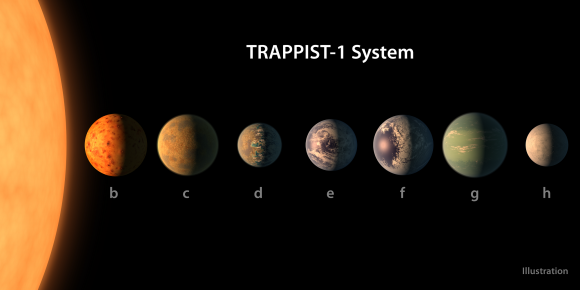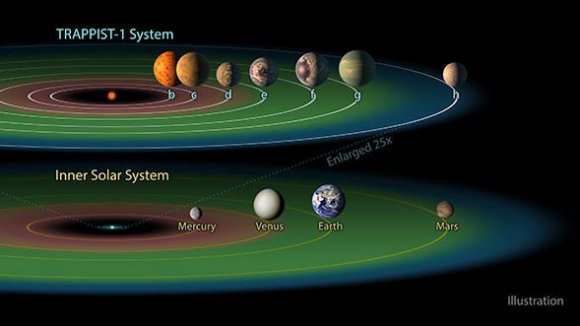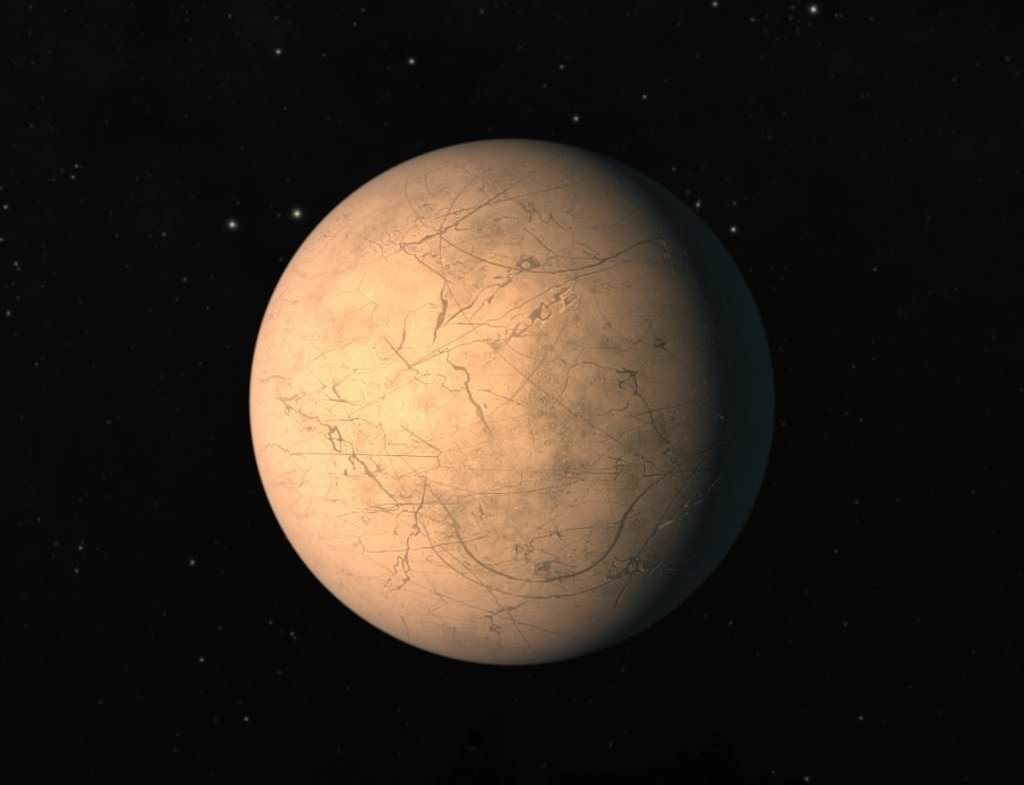The announcement of a seven-planet system around the star TRAPPIST-1 earlier this year set off a flurry of scientific interest. Not only was this one of the largest batches of planets to be discovered around a single star, the fact that all seven were shown to be terrestrial (rocky) in nature was highly encouraging. Even more encouraging was the fact that three of these planets were found to be orbiting with the star’s habitable zone.
Since that time, astronomers have been seeking to learn all they can about this system of planets. Aside from whether or not they have atmospheres, astronomers are also looking to learn more about their orbits and surface conditions. Thanks to the efforts of a University of Washington-led international team of astronomers, we now have an accurate idea of what conditions might be like on its outermost planet – TRAPPIST-1h.
According to the team’s study – “A seven-planet resonant chain in TRAPPIST-1“, which was recently published in the journal Nature Astronomy – they relied on data from the Kepler mission to determine the planet’s orbital period. Specifically, they consulted data obtained during Campaign 12 of the K2 mission, a 79-day observation period that ran from December 15th, 2016 to March 4th, 2017.

Led by Rodrigo Luger, a graduate student at the University of Washington, the team was already aware of pattern in the orbits of the system’s six inner planets. This was based on prior data provided by the Spitzer Space Telescope, which indicated that these planets are in an orbital resonance – i.e. their respective orbital periods are mathematically related and influence one other.
From this data, the team had already calculated that TRAPPIST-1h would have an orbital period of just less than 19 days. Once they consulted the K2 data, they noticed that during the 79-day observation period, TRAPPIST-1h made four transit of the star – which worked out to an orbital period of 18.77 days. In other words, the team found that their observations were consistent with their calculations.
This finding was a welcome relief to Luger and his colleagues. As he stated in a UW press release:
“TRAPPIST-1h was exactly where our team predicted it to be. It had me worried for a while that we were seeing what we wanted to see. Things are almost never exactly as you expect in this field – there are usually surprises around every corner, but theory and observation matched perfectly in this case.”
The discovery of this resonance means that TRAPPIST-1 has set another record. For starters, it is already renowned from being one of only two star systems to host seven extra-solar planets – the other being the HR 8832 star system, a main-sequence K3V-type variable star located 21 light years away. Second, it has the most confirmed terrestrial planets to be discovered in a single star system to date.

But with this latest data, TRAPPIST-1 now holds the record for having the most planets in an orbital resonance as well. The previous place holders were Kepler-80 and Kepler-223, both of which have four planets in an orbital resonance. According to Luger, this resonance was likely established when the TRAPPIST-1 system was still young and the planets were still in the process of formation. As Luger explained:
“The resonant structure is no coincidence, and points to an interesting dynamical history in which the planets likely migrated inward in lock-step. This makes the system a great testbed for planet formation and migration theories. We could therefore be looking at a planet that was once habitable and has since frozen over, which is amazing to contemplate and great for follow-up studies.”
The possibility that the planets achieved their current orbital dance early in the system’s history could also mean that TRAPPIST-1h was once habitable. While three planets orbit with the star’s habitable zone (TRAPPIST-1 d, e, and f), TRAPPIST-1h orbits the star at a distance of about 10 million km (6 million mi), which places it well beyond the reach of the star’s habitable zone.
In fact, at this distance, TRAPPIST-1h gets about as much energy from the Sun as the dwarf planet Ceres (located in our Solar System in Main Asteroid Belt, between Mars and Jupiter), which results in an average surface temperature of 173 K (-100 °C; -148 °F). But in the past, when its star was brighter and hotter, the planet may have received enough energy that its surface would have been warm enough to support liquid water.

“We could therefore be looking at a planet that was once habitable and has since frozen over, which is amazing to contemplate and great for follow-up studies,” said Luger. TRAPPIST-1 is also a prime candidate for follow-up study given its proximity. Located just 39.5 light years from Earth, this star and its system of planets present some exceptional opportunities for the study of exoplanets and M-type star habitability.
Beyond that, this study also demonstrated that despite the failure of two reaction wheels, the Kepler mission is still extremely useful when it comes to the study of exoplanets. Despite the fact that maintaining a steady eye on the TRAPPIST-1 system presented instrumental challenges, Kepler still managed to produce reliable information that was consistent with the team’s calculations.
Besides determining TRAPPIST-1h’s orbital period, the team used the K2 data to further characterize the orbits of the other six planets, rule out the possibility of there being more planets in the system, and learn more about the star itself (such as its rotation period and level of activity). This information will also be crucial in determining whether or not any of the planets located within the star’s habitable zone could in fact be habitable.
The discovery of the TRAPPIST-1’s system was an event that was many years in the making. But the rate at which new discoveries have turned up has been very impressive. In the coming years, with the deployment of next-generation planet-hunters – like the James Webb Telescope and the Transitting Exoplanet Survey Satellite (TESS) – we will be able to dig deeper and learn even more.
And be sure to enjoy this video of TRAPPIST-1’s orbital resonance, courtesy of Assistant Professor Daniel Fabrycky of the University of Chicago:
Further Reading: UW Today, Nature Astronomy


“But in the past, when its star was brighter and hotter, the planet may have received enough energy that its surface would have been warm enough to support liquid water.”
Don’t main sequence stars get hotter and brighter as they age, not the other way around?